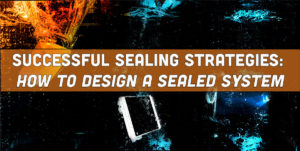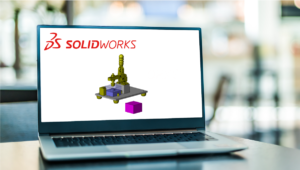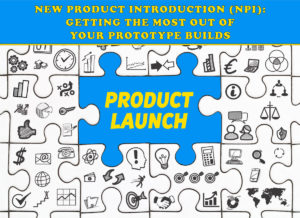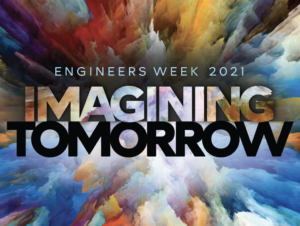After a second full year of the pandemic, supply chains for numerous goods, components, and materials continue to be in crisis. The importing companies of the Port of Los Angeles,… Read More
DESIGN CONSIDERATIONS DURING SUPPLY CHAIN SHORTAGES

| by Lori Rhodig

After a second full year of the pandemic, supply chains for numerous goods, components, and materials continue to be in crisis. The importing companies of the Port of Los Angeles,… Read More
| by Tristan Dudik

Sealing is challenging and important Whether it’s a waterproof wearable electronic device, a chemical bottle, hydraulic lines in automotive brakes, or the hull of a wooden boat, sealed assemblies are… Read More
| by Neil Foxman

Transforming your mechanical CAD designs into real and tangible parts is one of the most rewarding feelings as an engineer. However, a lot of things can go wrong during this… Read More
| by The Bridesmaids

Turn Around, Bright Eyes After two years of coming in second place, it was time for The Bridesmaids to become the bride; the corpse bride, that is. With a theme… Read More
| by Amy Cheben

Configurations are a powerful tool in SOLIDWORKS which allow users to maintain multiple versions of a part or an assembly in a single file. Like many features in SOLIDWORKS, Configurations… Read More
| by Chris Goetchius

Problems are inevitable in any engineering build process. As a result, problem solving is an engineering fundamental. Often, this process is straightforward. A screw is found to be loose; a… Read More
| by Jeff Wield

Your first draft of the design looks good on paper. You are one step closer to realizing your vision of the product. The technology concepts were proven to work on… Read More
| by Pam Roper

This blog is written for LabVIEW programmers familiar with LabVIEW Projects, case structures, enums, clusters, custom controls (.ctl), and non-reentrant VI’s (virtual instruments). Classes are an underutilized but useful tool… Read More
| by Doug Harriman

A clear demarcation between a green and a seasoned firmware (FW) engineer is the level of understanding, care, and planning that is evident in their work. The green engineer typically… Read More

Founded by The National Society of Professional Engineers (NSPE) in 1951, National Engineers Week is dedicated to ensuring a diverse and well-educated future engineering workforce by increasing the understanding of and… Read More
The Simplexity team can be as involved in the production phase as requested by our clients. For clients with internal manufacturing or established relationships with contract manufacturers, our engineers are available to ensure quality is maintained and provide ongoing engineering support as needed.
Simplexity has a dedicated New Product Introduction (NPI) team that can guide the transition from design into production. The NPI team presents multiple options for manufacturing to the client, allowing clients to choose the solution that best suits their needs. This can involve Simplexity performing initial builds in-house prior to full handoff to a contract manufacturer or building the product via established relationships with contract manufacturing partners either domestically or overseas early in the process.
This phase occurs once the detailed design is complete, and prototypes are built with manufacturing-representative quality and detail. More extensive, formal testing is performed, such as life, reliability, safety, environmental, drop, and vibration.
The design team works closely with the manufacturing team to enable a smooth transfer, often with Simplexity engineers traveling to the contract manufacturer sites to ensure product quality. The design is transferred to the client based upon specific needs, most often after all tests are complete and the design is verified.
Phase 2C iterates on the learnings of Phase 2B and involves a refined prototype build of a fully integrated system. Some projects also benefit from additional iterations of the product based on prior learnings through additional phases (2D, 2E, etc), which are not represented in this graphic. All requirements are intended to be tested, and at the end of Phase 2 there will be confidence that the units will pass verification in Phase 3. The Bill of Materials is further refined, and the team updates estimates for the per unit cost of the product by receiving pricing from vendors and suppliers.
The detailed design phase usually has multiple, iterative sub-phases as the design progresses and representative prototypes are built. Phases 2B and 2C are typically the largest efforts in the product development process, where the specific implementation for all disciplines occurs (mechanical, industrial design, electrical, firmware, systems, software, manufacturing, and quality).
Simplexity typically engages with production component suppliers and contract manufacturing groups early in this phase to provide additional manufacturing input on the design. If the product has stringent testing or certification requirements, pre-screens are performed in this phase prior to formal regulatory agency testing.
Phase 0 is an optional phase for projects where the technical feasibility of the idea has not yet been fully proven. It can consist of research, concept work, exploring initial architecture, performing feasibility studies, and basic prototyping and testing.
The business and user requirements are converted into engineering requirements for the product. The project planning activity is based on the schedule, budget, risk, and initial product requirements. This process is best done as a collaborative team effort with the client, who has the deepest understanding of the market needs and user requirements.
The detailed design phase starts with defining options for the product architecture, with the goal of having the greatest chance of successfully meeting product requirements while best mitigating risk. Engineering activities in this phase include presenting options for hardware components, outlining the system block, sequence, and state diagrams, creating rough CAD, and breadboarding of high-risk subsystems. Results are presented with a description of the pros, cons, and key tradeoffs for each scenario.
